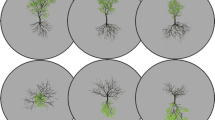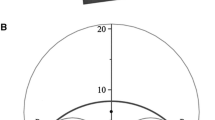Summary
The paths followed by grain weevils (Sitophilus granarius) in a featureless environment are curved or circular. Animals walking in circles display average angular velocities that may exceed 10°/s. The circling is not due to any asymmetrical damage to the weevil's limbs. Circling weevils walking on a sloping surface follow characteristic paths: on slight slopes the circles become cycloids, which in turn, become relatively straight paths on steep slopes. The mean direction of the cycloidal paths deviates from the direction of the straight paths. Left circlers deviate to the left and right circlers deviate to the right. These results can be explained by a feedback control loop with an additive interaction of internal and feedback signals. The cycloid paths thus result from an unstable state of the feedback loop in which the feedback signal from the gravity receptors is always smaller than the internal signal.
Similar content being viewed by others
References
Bässler K (1965) Proprioceptoren am Subcoxal- und Femur-Tibia-Gelenk der StabheuschreckeCarausius morosus und ihre Rolle bei der Wahrnehmung der Schwerkraftrichtung. Kybernetik 2:168–193
Birukow G (1964) Aktivitäts- und Orientierungsrhythmik beim Kornkäfer (Calandra granaria L.) Z Tierpsychol 21:279–301
Edrich W (1971) Die Licht- und Schwerkraftorientierung der Honigbiene. Dissertation München
Götz KG, Gambke C (1968) Zum Bewegungssehen des MehlkäfersTenebrio molitor. Kybernetik 4:225–228
Hischer R (1973) Bewertung und Verrechnung von Licht- und Schwerkraftrichtungen bei der Orientierung des Kornkäfers (Calandra granaria L.) in Simultanreizfeldern. Dissertation Göttingen
Holst E von (1950) Die Arbeitsweise des Statolithenapparates bei Fischen. Z Vergl Physiol 32:60–120
Horn E, Kessler W (1975) The control of antennae lift movements and its importance on the gravity reception in the walking blowfly,Calliphora erythrocephala. J Comp Physiol 97:189–203
Horn E, Lang HG (1978) Positional head reflexes and the role of the prosternai organ in the walking fly,Calliphora erythrocephala. J Comp Physiol 126:137–146
Horsmann U, Heinzel HG, Wendler G (1983) The phasic influence of self-generated air current modulations on the locust flight motor. J Comp Physiol 150:427–438
Huber F, Kleindienst HU, Weber T, Thorson J (1984) Auditory behavior of the cricket. III. Tracking of male calling song by surgically and developmentally one-eared females, and the curious role of the anterior tympanum. J Comp Physiol A 155:725–738
Jander JP (1982) Untersuchungen zum Mechanismus und zur zentralnervösen Steuerung des Kurvenlaufs bei Stabheuschrecken (Carausius morosus). Dissertation Universität Köln
Jander R (1957) Die optische Richtungsorientierung der Roten Waldameise (Formica rufa L.). Z Vergl Physiol 40:162–238
Jander R (1963) Grundleistungen der Licht- und Schwereorientierung von Insekten. Z Vergl Physiol 47:381–430
Kramer E (1975) Orientation of the male silkmoth to the sex attractant bombykol. In: Denton DA, Coghlan JP (eds) Olfaction and taste V. Academic Press, New York, pp 329–335
Kramer E (1976) The orientation of walking honeybees in odour fields with small concentration gradients. Physiol Entomol 1:27–37
Lindauer M, Nedel JO (1959) Ein Schweresinnesorgan der Honigbiene. Z Vergl Physiol 42:334–364
Linsenmair KE (1973) Die Windorientierung laufender Insekten. Fortschr Zool 21:59–79
Markl H (1962) Borstenfelder an den Gelenken als Schweresinnesorgane bei Ameisen und anderen Hymenopteren. Z Vergl Physiol 45:475–569
Mittelstaedt H (1961) Probleme der Kursregelung bei frei beweglichen Tieren. In: VDE (ed.) Aufnahme und Verarbeitung von Nachrichten durch Organismen. Hirzel, Stuttgart, pp 138–148
Mittelstaedt H (1962) Control systems of orientation in insects. Annu Rev Entomol 7:177–198
Mittelstaedt H, Mittelstaedt ML (1973) Mechanismen der Orientierung ohne richtende Außenreize. Fortschr Zool 21:46–58
Reichardt W, Poggio T (1975) A theory of the pattern induced flight orientation of the flyMusca domestica. II. Biol Cybern 18:69–80
Scharstein H (1975) Der Mechanismus der Sollwertverstellung bei der Kursregelung der roten Waldameise (Formica polyctena). Dissertation Universität München
Schöne H (1954) Statocystenfunktion und statische Lageorientierung bei dekapoden Krebsen. Z Vergl Physiol 36:241–260
Schöne H (1962) Optisch gesteuerte Lageänderungen (Versuche an Dytiscidenlarven zur Vertikalorientierung). Z Vergl Physiol 45:590–604
Urban F (1931) Der Lauf der entflügelten Honigbiene (Apis mellifica) zum Licht und der Einfluß von Eingriffen an Receptoren, Centralnervensystem und Effectoren. Z Wiss Zool 140:291–355
Wendler G (1965) Über den Anteil der Antennen an der Schwererezeption der StabheuschreckeCarausius morosus. Br. Z Vergl Physiol 51:60–66
Wendler G (1969) Was messen die Beine vonCarausius morosus beim Ermitteln der Schwerkraftrichtung? Verh Dtsch Zool Ges 1968, Zool Anz [Suppl] 32:439–444
Wendler G (1971) Gravity orientation in insects: The role of different mechanoreceptors. In: Gordon SA, Cohen MJ (eds) Gravity and the organism. University of Chicago Press, Chicago London, pp 195–201
Wendler G (1972) Körperhaltung bei der Stabheuschrecke: ihre Beziehung zur Schwereorientierung und Mechanismen ihrer Regelung. Verh Dtsch Zool Ges 1972, Zool Anz [Suppl] 65:214–219
Wendler G (1974) The influence of proprioceptive feedback on locust flight co-ordination. J Comp Physiol 88:173–200
Wendler G (1975) Physiology and systems analysis of gravity orientation in two insect species (Carausis morosus, Calandra granaria). Fortschr Zool 23:33–48
Wendler G, Dambach M, Schmitz B, Scharstein H (1980) Analysis of the acoustic orientation behavior in crickets (Grylluscampestris L.) Naturwissenschaften 67:99–100
Wilson DM, Hoy RR (1968) Optomotor reaction, locomotory bias, and reactive inhibition in the milkweed bugOncopeltus and the bettleZophobas. Z Vergl Physiol 58:136–152
Author information
Authors and Affiliations
Rights and permissions
About this article
Cite this article
Wendler, G., Scharstein, H. The orientation of grain weevils (Sitophilus granarius): Influence of spontaneous turning tendencies and of gravitational stimuli. J. Comp. Physiol. 159, 377–389 (1986). https://doi.org/10.1007/BF00603983
Accepted:
Issue Date:
DOI: https://doi.org/10.1007/BF00603983




